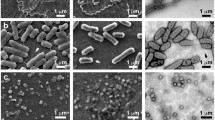Summary
The peptide antibiotic polymyxin B, has been used as a label in a freeze-fracture cytochemical study of anionic phospholipids in the plasma membrane of uterine epithelial cells. The reagent produces mainly circular lesions visible on both P and E faces of fractured membranes. IMPs are found to be associated with lesions and we consider the possible association of integral membrane proteins with anionic phospholipids as well as the mechanisms of lesion formation.
Similar content being viewed by others
References
Bearer EL, Friend DS (1980) Anionic lipid domains: correlation with functional topography in a mammalian cell membrane. Proc Natl Acad Sci USA 77:6601–6605
Bearer EL, Friend DS (1982) Modifications of anionic-lipid domains in guinea pig sperm. J Cell Biol 92:604–615
Branton D, Bullivant S, Gilula NB, Karnovsky MJ, Moor H, Muhlethaler K, Northcote DH, Packer L, Satir B, Satir P, Speth V, Stachelin LA, Steere RL, Weinstein RS (1975) Freeze-etching nomenclature. Science (NY) 190:54–56
Conrad MJ, Singer SJ (1979) Evidence for a large internal pressure in biological membranes. Proc Natl Acad Sci USA 76:5205–5206
Deamer DW (1977) The relation of membrane structure to membrane function. In: Jamieson GA, Robinson DM (eds) Mammalian plasma membranes, vol. 4. Butterworths, London, pp 1–31
Everett JW (1948) Progesterone and estrogen in the experimental control of ovulation time and other features of the estrous cycle in the rat. Endocrinology 43:389–405
Hartmann W, Galla HJ, Sackmann E (1978) Polymyxin binding to charged lipid membranes: an example of co-operative lipid-protein interaction. Biochim Biophys Acta 510:124–139
Ljungkvist I (1971) Attachment reaction of rat uterine luminal epithelium. I. Gross and fine structure of the endometrium of the spayed, virgin rat. Acta Soc Med Upsal 76:91–109
Lounatmaa K, Nanninga N (1976) Effect of polymyxin on the outer membrane of Salmonella typhimirium: freeze-fracture studies. J Bacteriol 128:665–667
Lounatmaa K, Makela PH, Sarvas M (1976) Effect of polymyxin on the ultrastructure of the outer membrane of wild-type and polymyxin-resistant strains of Salmonella. J Bacteriol 127:1400–1407
McNutt NS (1977) Freeze-fracture techniques and applications to the structural analysis of the mammalian plasma membrane. In: Poste G, Nicolson GL (eds) Dynamic aspects of cell surface organization. North-Holland, Amsterdam, pp 75–126
Murphy CR, Bradbury S (1984) Colloidal iron hydroxide staining of surface carbohydrates after glycerol treatment of uterine epithelial cells. Histochemistry 80:45–48
Murphy CR, Swift JG (1983a) pronase reduces intramembranous particle density in uterine epithelial cells in vivo. Acta Anat 116:174–179
Murphy CR, Swift JG (1983b) Relationships between intramembranous particles and surface coat carbohydrates in cells of a compact tissue. J Cell Sci 64:123–136
Murphy CR, Swift JG, Mukherjee TM, Rogers AW (1982) Changes in the fine structure of the apical plasma membrane of endometrial epithelial cells during implantation in the rat. J Cell Sci 55:1
Nilsson O (1958) Ultrastructure of mouse uterine epithelium under different oestrogenic influences. I. Spayed animals and oestrous animals. J Ultrastruct Res 1:375–396
Rogers PAW, Gannon BJ (1981) The vascular and microvascular anatomy of the rat uterus during the oestrous cycle. Aust J Exp Biol Med Sci 59:667–679
Schindler PRG, Teuber M (1975) Action of polymyxin B on bacterial membranes: morphological changes in the cytoplasm and in the outer membrane of Salmonella typhimurium and Escherichia coli B. Antimicrob Agents Chemother 8:95–104
Severs NJ, Robenek H (1983) Detection of microdomains in biomembranes: an appraisal of recent developments in freeze-fracture cytochemistry. Biochim Biophys Acta 737:373–408
Sheetz MP, Singer SJ (1974) Biological membranes as bilayer couples. A molecular mechanism of drug-erythrocyte interactions. Proc Natl Acad Sci USA 71:4457–4461
Sixl F, Galla HJ (1981) Polymyxin interaction with negatively charged lipid bilayer membranes and the competitive effect of CA2+. Biochim Biophys Acta 643:626–635
Teuber M, Miller IR (1977) Selective binding of polymyxin B to negatively charged lipid monolayers. Biochim Biophys Acta 467:280–289
Author information
Authors and Affiliations
Rights and permissions
About this article
Cite this article
Murphy, C.R., Martin, B. Freeze-fracture cytochemistry with polymyxin B. Histochemistry 80, 327–331 (1984). https://doi.org/10.1007/BF00495412
Accepted:
Issue Date:
DOI: https://doi.org/10.1007/BF00495412




